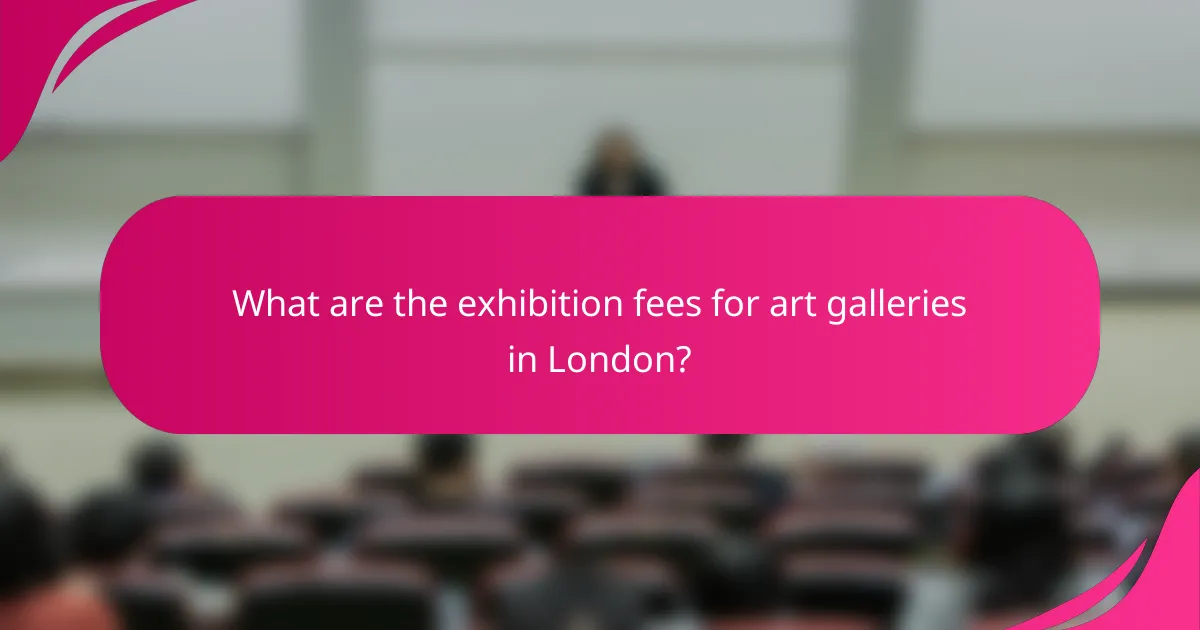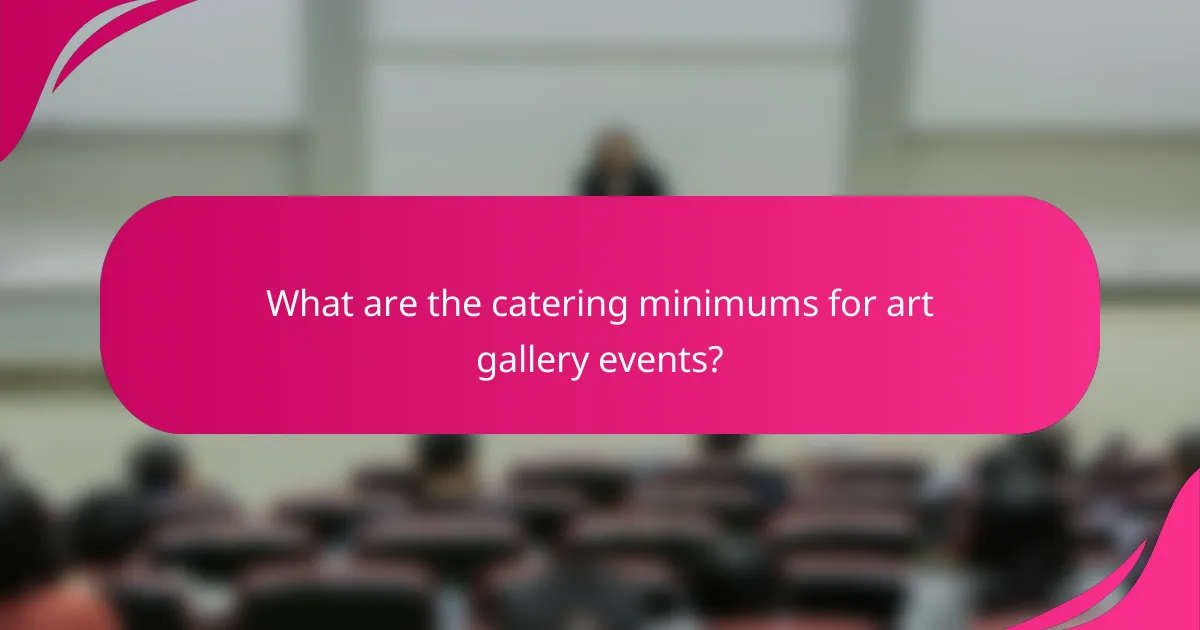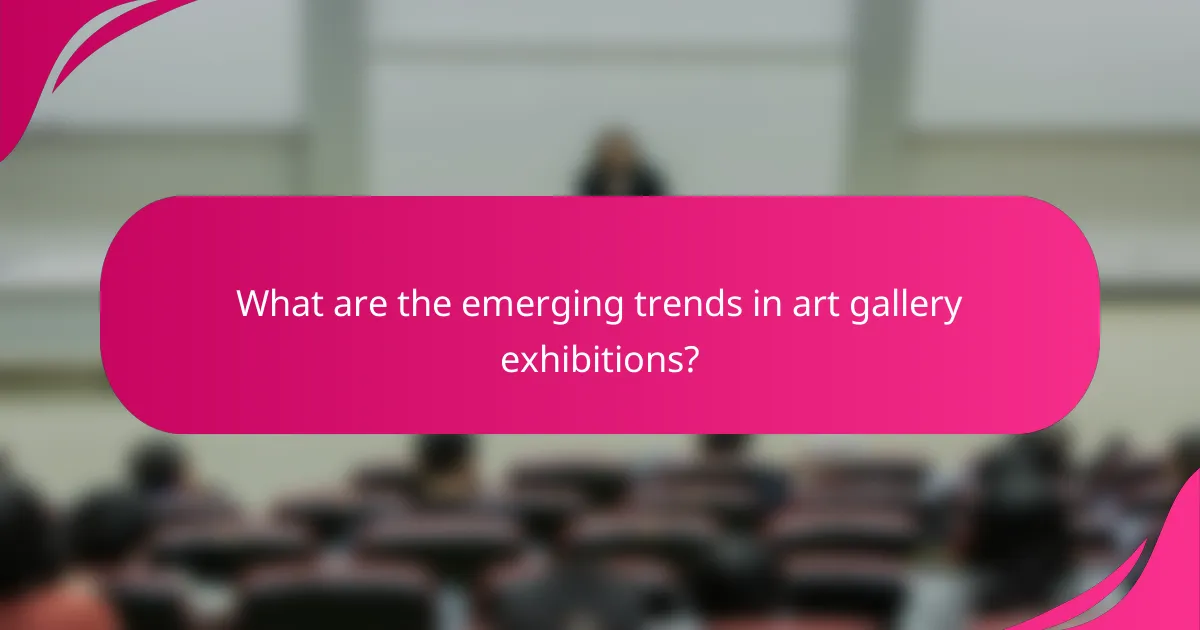When planning an exhibition at an art gallery, it’s essential to consider various costs, including exhibition fees, insurance, and catering minimums. Exhibition fees in London can range from several hundred to several thousand pounds, influenced by the gallery’s prestige and location. Additionally, insurance costs depend on the artwork’s value and coverage needs, while catering minimums vary based on the venue and event scale, ensuring quality service for attendees.

What are the exhibition fees for art galleries in London?
Exhibition fees for art galleries in London typically range from several hundred to several thousand pounds, depending on various factors such as the gallery’s prestige and location. These fees cover the costs associated with showcasing artwork, including marketing, space rental, and administrative support.
Standard exhibition fees
Standard exhibition fees in London art galleries usually start around £500 and can go up to £5,000 or more for high-profile venues. This fee often includes basic services like wall space, lighting, and some promotional efforts. It’s essential to clarify what is included in the fee before committing.
Some galleries may charge a flat rate, while others might have tiered pricing based on the duration of the exhibition or the number of artworks displayed. Always inquire about any additional costs that may arise during the exhibition period.
Variable fees based on gallery size
The size of the gallery significantly impacts exhibition fees. Larger galleries with more foot traffic and better visibility often charge higher fees, sometimes exceeding £10,000. In contrast, smaller, emerging galleries may offer more affordable rates, ranging from £300 to £1,500.
When considering a gallery, evaluate not only the fee but also the potential audience reach and the gallery’s reputation. A higher fee might be justified if the gallery has a strong track record of attracting buyers and collectors.
Discounts for local artists
Many galleries in London offer discounts for local artists, recognizing the importance of supporting the community. These discounts can range from 10% to 50% off standard fees, depending on the gallery’s policies. Local artists should inquire about specific programs or initiatives that promote their work.
Additionally, some galleries may provide opportunities for local artists to exhibit for free during special events or community showcases. Engaging with the gallery’s management can reveal potential savings and collaborative opportunities.

How much does insurance cost for art exhibitions?
The cost of insurance for art exhibitions varies widely based on factors such as the value of the artwork, the duration of the exhibition, and the specific coverage required. Generally, premiums can range from a few hundred to several thousand dollars, depending on these variables.
Average insurance premiums in the UK
In the UK, average insurance premiums for art exhibitions typically fall between £300 and £1,500 for standard coverage. High-value exhibitions featuring significant artworks may incur premiums exceeding £2,000. It’s essential to obtain quotes from multiple insurers to find the best rate for your specific needs.
Factors affecting insurance costs
Several factors influence the cost of insurance for art exhibitions. The primary considerations include the total value of the artwork, the location of the exhibition, and the duration it will be on display. Additionally, the level of coverage, including protection against theft, damage, and liability, will significantly impact the premium.
Other factors include the security measures in place, such as surveillance systems and on-site security personnel, which can lower premiums. Exhibitions held in high-risk areas may also face higher costs due to increased risk assessments.
Recommended insurance providers
When seeking insurance for art exhibitions, consider reputable providers that specialize in art and cultural institutions. Companies like Hiscox, AXA Art, and Lloyd’s of London are known for their tailored coverage options and expertise in the art sector.
It’s advisable to compare policies and read reviews to ensure you choose a provider that meets your specific exhibition needs. Consulting with an insurance broker experienced in art coverage can also help navigate the options available.

What are the catering minimums for art gallery events?
Catering minimums for art gallery events vary widely depending on the venue and the scale of the event. Typically, galleries require a minimum spend on catering services to ensure quality and service standards are met.
Catering minimums for major London galleries
In major London galleries, catering minimums can range from around £1,500 to £5,000, depending on the size and prestige of the venue. Some galleries may have specific requirements for the number of guests, which can influence the minimum spend.
For example, a well-known gallery might require a higher minimum for evening events compared to daytime functions. It’s advisable to check directly with the gallery for their specific policies and minimums.
Popular catering options and costs
Common catering options for art gallery events include canapés, buffet-style meals, and plated dinners. Canapé services typically start at around £20 per person, while buffet options can range from £30 to £60 per person, depending on the menu selection.
For more formal events, plated dinners may cost between £50 and £100 per person. Consider the type of event and guest preferences when selecting catering options to ensure satisfaction.
Vendor recommendations for art events
When choosing a catering vendor for an art gallery event, look for those with experience in similar settings. Vendors like Gourmet Catering and Artisan Events are known for their quality service and creative menus tailored for gallery environments.
It’s beneficial to request references and sample menus from potential vendors. Additionally, consider scheduling tastings to ensure the food aligns with your event’s theme and guest expectations.

What criteria should be considered when choosing an art gallery?
When selecting an art gallery, consider factors such as location, accessibility, reputation, and the quality of past exhibitions. These elements can significantly influence the success of your exhibition and the experience of your visitors.
Location and accessibility
The location of the art gallery is crucial for attracting visitors. A central location with good public transport links can increase foot traffic, while a venue in a less accessible area may deter potential attendees. Consider the surrounding environment and whether it complements the theme of your exhibition.
Accessibility features, such as wheelchair ramps and parking options, are also important. Ensure that the gallery meets local regulations for accessibility to accommodate all visitors comfortably.
Gallery reputation and past exhibitions
The reputation of an art gallery can greatly affect the perception of your exhibition. Research the gallery’s history, including the artists it has showcased and the types of exhibitions it typically hosts. A well-regarded gallery can lend credibility to your work.
Look into past exhibitions to gauge the gallery’s audience and success rates. Consider reaching out to artists who have previously exhibited there to gather insights about their experiences and the gallery’s support during their shows.

What are the emerging trends in art gallery exhibitions?
Emerging trends in art gallery exhibitions focus on enhancing visitor experience and accessibility through innovative approaches. These trends include the rise of virtual exhibitions, collaborations with local artists, and the integration of technology to engage audiences more effectively.
Virtual exhibitions and online engagement
Virtual exhibitions allow galleries to reach a global audience by showcasing art online. This trend has gained momentum, especially post-pandemic, as galleries seek to maintain engagement with visitors who may not be able to attend in person.
To implement virtual exhibitions, galleries can utilize platforms that support 3D walkthroughs or live-streamed events. Costs for these services can vary, but many options are available at different price points, often starting from a few hundred to several thousand dollars depending on the complexity.
Collaborations with local artists
Collaborating with local artists fosters community engagement and supports regional talent. Galleries are increasingly curating exhibitions that highlight local creators, which can enhance the cultural relevance of their offerings.
These collaborations can take various forms, such as joint exhibitions, workshops, or community events. Galleries should consider setting a budget for artist fees, which can range from a few hundred to several thousand dollars, depending on the artist’s experience and the scope of the project.
Incorporating technology in exhibitions
Incorporating technology into exhibitions can enhance the visitor experience through interactive displays and augmented reality. This trend encourages deeper engagement with the artwork and can attract a tech-savvy audience.
Examples include using QR codes for additional information or virtual reality setups that allow visitors to immerse themselves in the art. Galleries should budget for technology investments, which can vary widely, from low-cost solutions to more expensive installations that could reach tens of thousands of dollars.



